Aristotle University of Thessaloniki, Greece
Department of Physical Education and Sport Science
Laboratory of
Ergophysiology-Ergometry
Correspondence:
Efstratios Vamvakoudis PhD, Assistant
Professor
Department of Physical Education and
Sport Science
Aristotle University of Thessaloniki,
Greece
Tel.:+30 2310991166
Email:vamvak@phed.auth.gr
Abstract
The purpose of the present study was: to record a) the
somatometric characteristics and body composition, b) the isokinetic strength
of lower limbs of some amateur female Greek volleyball players (VP) and to compare
them with untrained women (UW). The sample was consisted of twelve (n=12) VP and twelve (n=12) UW. All
subjects underwent anthropometric measurements, body fat assessment and lower
limb isokinetic strength testing for the evaluation of strength of quadriceps
and hamstrings. Height, body mass and fat free
mass values were significantly different for VP (p<.001, p<.01 p<.001 respectively) in comparison to UW. Isokinetic strength testing, revealed
significant differences for VP (p<.001) in all angular velocities (300, 180 and 60ο·sec-1), even when values were shifted into relative (nm·body mass-1). Hamstrings to quadriceps
ratio had no statistical differences between two groups. Conclusively, it seems
that VP selection in early age is an important factor which makes the height difference
to the UW and that chronic volleyball training can lead to significant
increases in strength, but no changes in hamstrings/quadriceps ratio.
KEY WORDS: Female
volleyball players, body fat, fat free mass, isokinetic strength.
Introduction
Volleyball is a very dynamic sport which is characterized from short
period of exercise alternating with rest. The long duration of the game makes the
athlete’s aerobic energy demand to increase. In contrast, the explosive nature
of the game comprised by blocks, attacks and fast court movements requires an
increased anaerobic capacity (Kustlinger, Ludwig, & Stegemann, 1987).
Throughout the game, volleyball players need to perform a lot of maximal
vertical jumps and thus they must have very well trained leg extensor muscles
(Pandy, Zajac, Sim, & Levine 1990; Bobbert & Van Soest, 1994). A very
important factor for the selection of female volleyball players in high level
is height. High stature has been recorded as a differential factor between
succeed and non-succeed teams (Morrow, Jackson, Hosler, & Kachurick, 1979).
In the same perspective, Spence, Disch, Fred & Coleman (1980), have recorded the descriptive profiles of
the selection of the intraUSA volleyball team. They mentioned that the players
who finally joined the national team had higher stature and bigger body mass
than the rejected players, while strength had no significant difference between
two groups. In another study by Morrow, Hostler, & Nelson (1980) the volleyball players appeared to be
significantly taller than untrained women, with bigger body mass and fat free
mass. In the same paper volleyball players had no significant differences in
somatometric factors with basketball players. Bayios, Bergeles, Apostolidis,
Noutsos, & Koskolou (2006) compared the somatometric characteristics of
female volleyball players with these of female handball and basketball players.
Their results also indicate that volleyball players had higher stature with
bigger body mass and lower fat percentage than the other two groups of
athletes. Tsunawake et al. (2003) reported though, that there was no
significant difference of the above factors between female volleyball and
basketball players. Fleck, Case, Puhl, & Van Handle (1985) compared the
physical characteristics between the national female volleyball team of the USA
with the intercollegiate team. They reported that the players of the national
team were significantly older, with lower percentages of body fat.
It seems likely that
female volleyball players’ physical characteristics are better than other team
sports players and untrained women.
Material and Methods
Subjects
In the present study
participated twelve (n=12) amateur female volleyball players and twelve (n=12)
untrained women. All the measurements occurred in the Laboratory of
Ergophysiology-Ergometry of the Aristotle University of Thessaloniki.
Somatometric Characteristics and Body Composition.
Height and body mass were recorded with an electronic weight scale
incorporated with a stature measure (Seca 220e, Hamburg,
Germany). For the calculation of body fat and fat free mass, a hydrostatic
weighting tank was used (Vacumed,
Ventura California). The vital capacity of
the lungs had previously been determined out of water, with the aid of a
spirometer (Jaeger,Germany). The
hydrostatic weighting tank was filled with water and was comprised of an
electronic weight scale from which a special seat was hanged. The subject was
sitting on that seat, submerging in water, exhaled voluntary all the air from
the lungs and then the underwater weight was recorded. With the value of vital capacity already recorded
out of water, the residual volume of the lungs was calculated. The values from
residual volume, underwater weight, ground weight, height, water temperature
were used in Brozek’s formula (Brozek, Grande, Anderson, & Keys, 1963), and
thus body fat and fat free mass were determined.
Strength Measurement
Lower limb strength was
measured at the isokinetic dynamometer (cybex II). Extensors and flexors of the
dominant leg were tested at the angular speeds of 300, 180 and 60ο sec-1 (Zakas, Mandroukas,
Vamvakoudis, Christoulas, & Aggelopoulou, 1995). The results were recorded
in absolute (Nm) and relative (Nm·Body weight-1) values.
Statistical Analysis
From the statistic
software SPSS, the “paired sample t-test” was used for the comparison of means
between the two groups of subjects.
Results
The somatometric
characteristics measurement (table 1) reveals that volleyball players (VP) had higher
stature than the untrained women (UW) (p< .001). Moreover VP had
significantly bigger body mass (p< .01) fat free mass (p< .001) and lower
percentages of body fat (p< .05).
|
Table 1. Somatometric characteristics. *
p< .05 **p< .01 ***p< .001 |
|||||
|
|
Age |
Height |
Weight |
Fat Free Mass |
Fat % |
|
VP |
21.57±2.07 |
1.77±0.05*** |
67.41±2.82** |
53.41±2.53*** |
20.41±3.95* |
|
UW |
22.14±0.75 |
1.63±0.03 |
50.94±9.49 |
39.58±3.93 |
26.31±4.61 |
|
|
|||||
A strong statistic
significant difference (p< .001) was observed in isokinetic strength
measurement (fig. 1) of leg extensors for all angular velocities (300, 180 and
60ο·sec-1), with the VP overmatching the UW. Similar
results are appeared in the isokinetic strength of leg flexors, where the VP
present significantly higher torque values (p< .001) than the UW (fig. 2).
Additionally, the relative strength (Nm·Body weight-1) revealed significant
difference between the two groups in both leg extensors and flexors (fig. 3 and
4). Finally, the flexors/extensors ratio (fig. 5) is the almost the same
between the two groups, without any statistical significant difference.
Fig 1. Strength of leg extensors in absolut values (***p< .001).
Volleyball players (VP) vs. untrained women (UW).
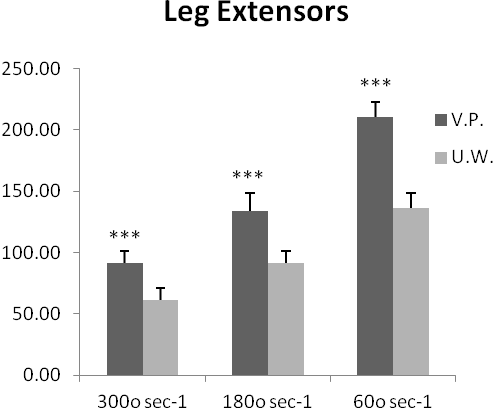
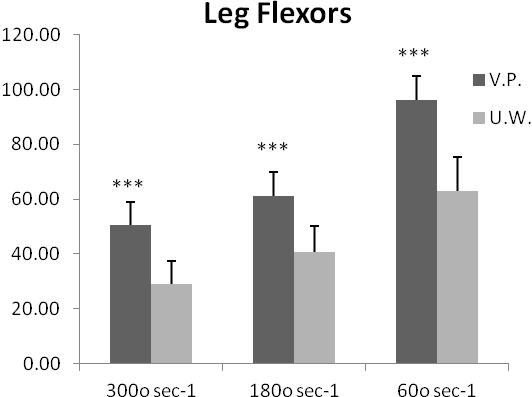
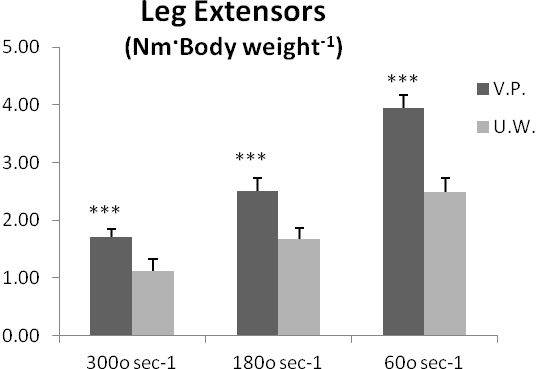
Fig 4. Strength of leg flexors in relative values (Nm·Body weight-1) (***p< .001). Volleyball players (VP) vs. untrained
women (UW).
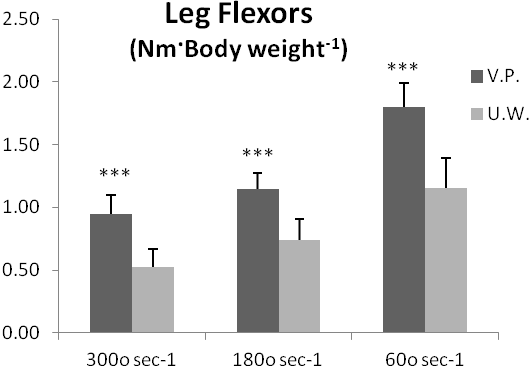
Fig 5. Hamstrings/quadriceps ratio. Volleyball players (VP) vs.
untrained women (UW).
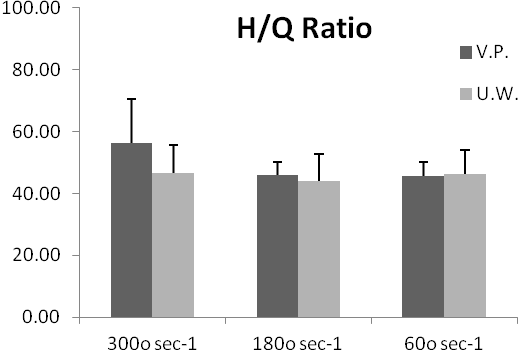
Discussion
The aim of the present study was to record a) the
somatometric characteristics and body composition, b) the isokinetic strength
of lower limbs of some amateur female Greek volleyball players and to compare
them with those untrained women.
The importance of
somatometric characteristics, particulary height and body weight, for the evolution
of volleyball players in high level has previously been examined (Morrow, Jackson, Hosler, &
Kachurick, 1979; Morrow, Hostler, & Nelson, 1980; Spence, Disch, Fred & Coleman, 1980). These previous studies shown that as the level of
volleyball becomes higher (intercollegiate teams, high level teams, national
teams) the athletes present high stature. Moreover, a concurrent increase of
body mass is often observed, which isn’t always accompanied by increases in
strength. An extra element that makes high level players to differ, is
technical skills and special characteristics at different game scenarios,
depending their playing position (e.g.setter, middle blocker, outside hitter,
universal) (Spence,
Disch, Fred & Coleman, 1980). Gualdi-Russo
& Zaccagni (2001) recorded the somatotype characteristics of the players in
the elite female Italian volleyball league. From their results it came an
average of 193.9±6.5 cm
for height, 88.4±7.7 kg
for weight and age 24.5±4.6.
For the second league of Italy recorded lower values of height and body mass and
about the same average of age. In our study, the Greek amateur volleyball
players had a stature of 177±0.05 cm
and 67.41±1.82 kg body mass. The
fact that our study’s players have lower stature seems probably to explain why are
they amateurs and why they don’t participate in a high level championship. Therefore,
previous observations (Morrow, Jackson, Hosler, & Kachurick, 1979; Morrow,
Hostler, & Nelson,
1980; Spence,
Disch, Fred & Coleman, 1980), supporting that height is a cruciate factor for the
palyers’ career seem to be confirmed, as the players of our study are not too
tall and thus participate in amateur championship. Comparing to untrained women,
female volleyball players appear to have (appart from higher stature), bigger
body mass and fat free mass (Morrow, Hostler, & Nelson,
1980). These results are in accoradance with the results of
our study, showing significantly (except higher stature), bigger body mass,
lower fat percentage, bigger fat free mass than the untrained women. Fleck, Case, Puhl, & Van Handle (1985) in their study, noted an
average body fat of 11.7 ± 3.7%,
and fat free mass 60.3 ±6.1 kg,
for the national team of USA. In the same investigation, the values for the
players of intercollegiate team were 18.3 ± 3.4 % body fat and 58.4 ±3.9 kg fat free mass. In another
study (Bayios, Bergeles, Apostolidis, Noutsos, & Koskolou, 2006), physical
attributes of volleyball, handball and basketball players playing in division 1
in Greece were compared. It was found that volleyball players were taller
(177.1±6.5 cm) than both basketball (174.7±7.8) and handball players (165.9±6.3). The volleyball players were
also heavier (69.5±7.4),
had a higher fat free mass (53.2±5.3) and lower percent fat (23.4±2.8) than the handball players.
Thus, it is evident that being tall and fat free is advantageous in volleyball.
Muscle strength is a very important aspect of the
athletic performance. There are several methods for the assesment of muscle
strength and different studies use different methodologies. Hence, comparing
results among other studies becomes a very difficult issue. In the study of Morrow, Jackson, Hosler, &
Kachurick, (1979), most successful players were
compared with less succeessful players in a volleyball tournament. Bench press
and leg press values were 46.45±11.04 and 155.42±27.39 kg, respectively, for the players of the
most successful teams, and 37.57±9.53 and 137.91±28.96 kg, respectively, for players of the
least successful teams. The same authors, in another study (Morrow, Hostler, & Nelson, 1980) revealed,
as expected, that volleyball players were stronger than non-players. Alfredson,
Pietila, & Lorentzon (1998), conducted some isokinetic tests in order to
compare concentric and eccentric shoulder and elbow strength in female
volleyball players and untrained women. Their results revealed that volleyball
players had significantly higher concentric and eccentric peak torque of the
shoulder and elbow rotator muscles. In another study of isokinetic strength
testing (Ferris, Signorile, &
Caruso, 1995), it was recorded that there was a significant between arm
extension torque and spike velocity. Our
results are in accordance with the previous research articles, as we found
statistical significant differences in all angular velocities of the isokinetic
strength between the volleyball players and the female non-active women.
Several studies have examined the effects of resistance
training programs on strength (Fry et al. 1991; Hakkinen, 1993; Marques, Tillaar,
Vescovi, & Gonzalez-Badillo, 2008; Smith, Stokes, & Kilb, 1987). In the study of Fry et al. (1991), the effects
of a 12 week strength training program in NCAA players was examined. Their
results revealed that starters were stronger than non-starters, and that starters
remained stronger than non-starters even when absolut values were turned into
relatives. Our results are in agreement with the above findings, as volleyball
players were significantly stronger than untrained women in absolut and
relative (nm·body mass-1) values too.
Conclusion
Conclusively, it seems that volleyball players’
selection in early age is the factor that makes the height difference between
them and the untrained women. Moreover, chronic volleyball training can lead to
significant increases in strength, but no changes in hamstrings/quadriceps
ratio.
References